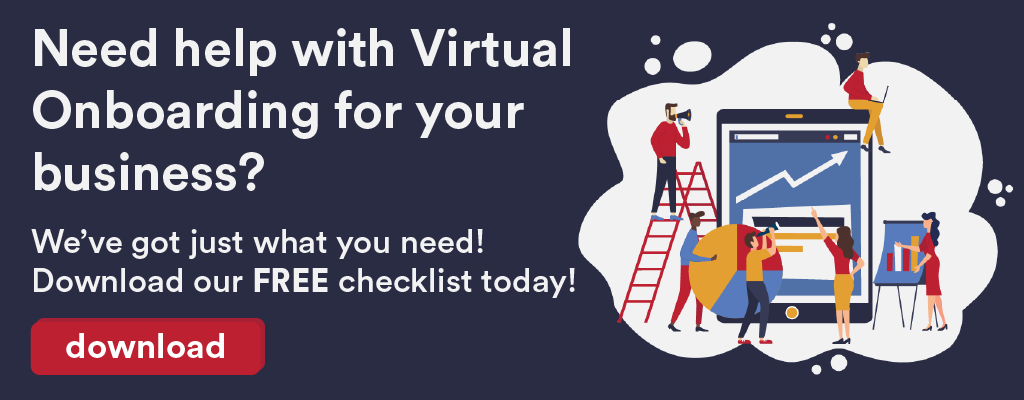With COVID-19 revolutionising the way we work, remote working has boomed and is set to soon become intrinsic to many business models around the world.
As we all continue to acclimate to this “new normal” and embrace new ways of working, there are a few factors of the employee experience that businesses still have to adapt to.
One pressing issue is when the time comes to hire, how will we properly welcome and set up new remote employees. The answer? Virtual onboarding.
An employee’s first day sets the standard for the rest of their time at your company. And although you may not be able to greet your employees face-to-face on day one as you usually would, you still want to put your company’s best foot forward and ensure your new hires are properly supported and set up for a successful career at your company.
If you want your business and staff to be post crisis ready, you will need to optimise your existing onboarding programs to be more inclusive of both in-house and digital audiences. But before we look at how to make tech your best friend, here’s a quick reminder of what virtual onboarding is and why it’s so crucial…
What Is Virtual Onboarding?
Virtual onboarding is essentially conducting the traditional in-person onboarding processes such as; orientation, meeting the team and training, to name a few, online.
They can be in the form of videos, quizzes, documents, presentations, and usually involve using communication programs like Teams or Slack. So the content and plan is the same, but the method is different.
Virtual onboarding allows you to connect with and engage new employees no matter where they are, letting you easily scale your current onboarding process allowing you to diversify your talent pool and cater to new flexible working arrangements.
Businesses looking to be successful at virtual onboarding are encouraged to use video conferencing, webinars, videos, text resources, and interactive exercises that new hires can access via their desktop, tablet, or mobile device so they may revisit them whenever they need throughout the onboarding process.
While virtual onboarding often takes place in conjunction with in-person onboarding, many companies are turning to a 100% virtual onboarding process as they continue to work around the COVID-19 pandemic.
How Long Should A Virtual Onboarding Last?
Although your new employee has most certainly already formed a first impression of your company after their first interview, the quality and timing of their onboarding will play a huge part in their long-lasting opinion of your business and will in most cases determine their desire to become a brand ambassador on the long term.
Whether physically or virtually onboarding your employees, we cannot emphasise enough how important it is to spread the process over several weeks or even months.
It is proven that learning crucial information over time rather than cramming over the span of a few days leads to a higher and more successful information retention rate. “Onboarding” new work processes, tools and knowledge works in the same way and as such should be organised in a similar fashion.
We also highly recommend starting the process a week before your new employee’s first day so as to foster excitement for your brand as well as help them feel more prepared and welcomed. By giving them the tools to discover the ins and outs of your business in their own time, your new remote employee will be more engaged and productive from the get-go.
All in all, we believe it takes about six months to get employees up to speed, which is what research indicates as the amount of time employees feel they start to add value.
However, this isn’t a one-size-fits-all situation and it can easily take nine to 12 months, depending on the role and size of your team.
Actions To Take For A Successful Virtual Onboarding
Before start date
– Create a guide to alleviate first day concerns
New hires are curious by nature, and tend to want to prepare in advance so as to make a first good impression as well become more comfortable with their new employer.
By providing more in depth details about your business in advance, not only will you help calm those first day jitters but also allow new hires to already feel like they belong to the company and their team.
We recommend giving a sneak peek of your business by sending every new hire a guide which showcases everything to expect on their first day. It doesn’t sound like much, but a helpful set of do’s and don’ts can do a lot to ease the mind, which then mentally prepares people for their new journey.
– Set new comers up with essential hardware & tools
To avoid any hiccups in communication, new hires should be up and running on their first day. To do so, you’ll want to make sure they have the necessary tools and equipment they require to work.
You can do so in two ways:
1. If you already have gear in-house, then it is worth organising for it to be sent in advance. Ideally, you should aim for it to get to them at least one week prior to their start date. This should include a laptop, mouse and keyboard at minimum.
2. If you don’t have equipment in-house or you want to save funds on postage costs, then you can allocate a clear budget for your remote employee to use to purchase the equipment themselves. Although this option is useful when your remote worker is located far away from one of your offices, it is also a little more complicated as your IT department will most likely spend more time remotely logging in to install all VPN or security measures that are required.
If this route speaks to you, we recommend setting clear guidelines on what type of equipment they’ll need to efficiently do their job, as well as a clear timeline as to when they need to have purchased the equipment by so that your IT department has sufficient time to setup. It is also incredibly important for them to keep receipts of all purchases and send them back to you for tax deductibles.
Regardless of which option you choose, you’ll want to arrange a test call a couple of days prior so as to make sure all software and platforms are correctly installed so your new hire is ready to start on their first day.
– Share company culture by gifting company swag
It is to be expected that it will take some time for your remote employee to truly feel part of your team. Distance, in general, makes it difficult to foster strong relationships, smooth communication and a sense of belonging.
However, the small things still matter and can make much more of a difference than you think.
If your teammate can’t be in the office, something that can help ease the process of “belonging” is by branding their home office.
Sending your company “welcome pack” a couple of days prior to their start date is a great way to “spruce up” their space, as well as help them feel part of the team. This also gives them the opportunity to share their new journey on social media, pushing them to become an ambassador from the start.
Low on cool company swag ideas or don’t yet have an employee “welcome pack”? There’s no better time to create one. At Polyglot Group, we have a t-shirt, travel tug, human hub (USB hub), glass water bottle and a keychain. Other ideas include pens, mugs, stickers, socks, etc.
The world is your oyster when it comes to goodies. Whatever you choose, they should reflect your brand and values.
– Help with completing onboarding documents
Although you may not think it necessary for new employees to fill out HR paperwork prior to their first day, doing so saves time so they can hit the ground running straight off the bat, rather than waste their first day signing policies & procedures and familiarising themselves with your company guidelines.
Sending the documents ahead of their start date also shows your new employee that your business is organised and on top of admin tasks.
Examples of documents you could send in advance include:
– Policies & Procedures (WHS, Performance & Misconduct; Complaints & Grievances; Equal Employment Opportunities & Anti-Discrimination; Social Media; Smoking, Drugs & Alcohol; Recruitment & Selection; Attendance, Hours of Work & Absenteeism; Working from Home; Internet, Email & Computer Use, etc.)
– Financial forms (tax, superannuation, direct debit, etc.)
– Expectations of the job – You should provide your new employee with a copy of their job description and their letter of offer as a reminder of what is expected of them.
– Emergency contact details – You should have a designated form to record the details of your new employee’s emergency contact in the event that an incident (or accident) happens at work.
When sending HR paperwork to your future remote worker, think ahead and pre-empt potential constraints. Since there is a high chance they won’t own a printer and scanner, why not invest in a tool that offers digital signatures?
There are many digital HR tools on the market that can help ease remote onboarding. If you’re considering having a large remote workforce, we recommend investing in one to ease the process for both you and your employees.
From Day One Onwards
– Foster personal connection
Positive relationships at work are a key ingredient for establishing and maintaining high employee engagement. For remote workers, the fact they have fewer in-person interactions with coworkers makes establishing those connections and friendships even more crucial.
At the same time, the limited opportunity for casual interactions with colleagues means creating and maintaining those kinds of relationships takes much more conscious effort. Without managers, team members, and even the organisation’s leaders putting in the time and effort to foster relationships with remote employees, it’s all too easy for those workers to feel isolated and left out.
Since the manager plays an integral role in how quickly, efficiently and enjoyably a new hire is onboarded, ramped up and embraced into company culture, we recommend they make it a priority to regularly connect with remote employees, from day one.
In order for this to be successful, it is important that the business as a whole supports managers and encourages them to make time for such interactions. This can easily be done by updating their role and responsibilities to cater to your new remote setup.
– Organise regular face to face catch-ups
Speaking of fostering personal connection, a great way to do this is by organising regular video calls so that both parties can visually see their counterpart. This will aid in reading body language as well as “humanise” the person behind the screen. This is incredibly important throughout the remote worker’s employment, but even more so in the very beginning.
As we know, joining a new organisation comes with a lot of excitement but can also trigger some anxiety around the unknown. A good way to counteract this is to organise several face to face meetings with your new hire during their onboarding so as to check in on them.
– Set clear goals & expectations
The best way to engage your new employee from day 1 is to set clear OKR and KPIs so that they have a full understanding of how they’re contributing to the greater business.
By defining clear goals to reach, this should also ease any discomfort or uncertainty towards where to start or what their purpose is within the team.
You’ll also want to highlight the team’s objectives and explain how performance will be assessed over time so that there aren’t any surprises later. The key here is to make transparency a priority in your communication so as to make sure there are no misunderstandings or miscommunications.
– Schedule bonding time
In a similar fashion to fostering connection, scheduling in “bonding time” is greatly important throughout a remote worker’s employment. Working from home has its benefits, but it can also make it difficult to sense the company culture or even get to know your coworkers.
Genuine connection and conversation are of the utmost importance to keep employees engaged. When thinking about your next onboarding, you’ll want to set aside specific times to bond as a team as well as think outside the box about activities to do together for your new hire to feel welcome and part of the team.
Perhaps look at implementing a virtual “Friday Drinks” session, a virtual dinner experience or even a virtual escape room to bond as a team.
– Allocate a buddy
Buddy programs are a great way to help your new employee settle more comfortably and more efficiently. The concept involves assigning a new employee to an existing staff member, so that they have a safe place (or person in this case) to go to ask questions and get a general feel on the ins and outs of your business.
Spread over several weeks or months, a buddy program helps employees feel welcome and gain insight to inside information they wouldn’t have otherwise. We recommend choosing someone that isn’t already part of their team or their manager so as to diversify their connections within the business.
It usually takes about 3 months for an employee to get accustomed to the business, so when you add distance, it can sometimes take double the time. In this case, perhaps look at increasing your buddy program to last between 3 to 5 months for remote staff.
Challenges Of Remote Onboarding
Onboarding a new employee isn’t always smooth sailing, even when done face to face. Yet, when you add distance to the fold, usual challenges can become more difficult to handle.
Keeping them in mind will enable you to better prepare for them and therefore hopefully counteract their effects.
Typical challenges you might face include, but aren’t limited to:
Lack of understanding of your company culture
Company culture is not something you read about and then act upon but rather something you experience. Unfortunately, doing so is much harder when joining a new company remotely.
Lacking physical presence and with limited opportunities for free conversation and collaboration, grasping the company culture may take a little longer for remote workers. This doesn’t mean it will be impossible, however it will definitely require more effort and input to foster culture at a distance.
Ideas to ease this process include:
– Organising remote work drinks
– Creating and fostering a “kit and caboodle” or fun company chat channel where employees can share fun facts or funny GIFs
– Wishing staff birthdays, anniversaries, achievements and milestones digitally so that the whole business may celebrate together, regardless of distance.
– Sharing company or team achievements in the same fashion to promote transparency and team bonding.
Miscommunication & disconnection
Clear and efficient communication often comes with connection. Conversely, a lack of communication partly due to working from home conditions may lead to a feeling of disconnection and lack of clarity. This can have considerable consequences on your employees’ mental health, especially for new ones.
This is why, when onboarding a newcomer, it is important to schedule regular “checking in” sessions to remain connected and avoid miscommunications. This is your chance to keep the person engaged in conversation as well as allocate time to recreate the “water cooler moments” that would usually occur in the office.
Worth keeping in mind that when onboarding someone from a distance, there is no such thing as “over-communicating”. Whilst getting to know your new employee, there will always be an adjustment period for both parties, and it is best to make 100% sure they fully understand everything that is expected of them so as to avoid pent up frustration. Open and constructive feedback is key!
Lack of structure & time
It may feel natural to believe that “time is of the essence” in business. Understandably, the need for haste in action or response is of the utmost importance to remain relevant and seize opportunities.
In the context of onboarding however, it couldn’t be further from the truth. Winging a virtual onboarding process and not taking the time to create a structured plan can (and most certainly will) cause issues and complications down the road.
In an office setting where there is little to no physical distance, it is easier to “go with the flow” and gage uncertainties as they come. However, as soon as you add distance, the situation automatically becomes more complex for both the new employee and the manager.
Overcoming such a challenge all comes down to structure and making time. The more prepared you are and the more resources you provide, the better informed and efficient your new hire will be.
Making peace with the fact that your remote teams might have more questions is also crucial. The more patient you are with them and with yourself, and the more time you allocate towards knowledge sharing, the more productive you will become in the long run.
Lastly, by making time to be present for your remote teams, you’ll also get the opportunity to retrieve feedback more naturally. This will help you improve your onboarding process as you go, but also help you quickly identify any gaps or inconsistencies in knowledge and training, so that you may rectify them more efficiently.
As we’ve discovered above, a strong and structured onboarding is crucial to boost productivity, engagement, and talent retention
Yet, although onboarding programs have been around for many years, many businesses are yet to have a defined strategy for success, and tend to approach them “on the fly”.
With remote working set to become an intricate part of the future of work, businesses that wish to set themselves apart from their competitors as well as succeed post crisis are going to need to seriously look at how they will adapt their onboarding to fit within this new reality.
With that in mind, what steps will your business take today to be ready for tomorrow?













 June 11, 2020
June 11, 2020 








